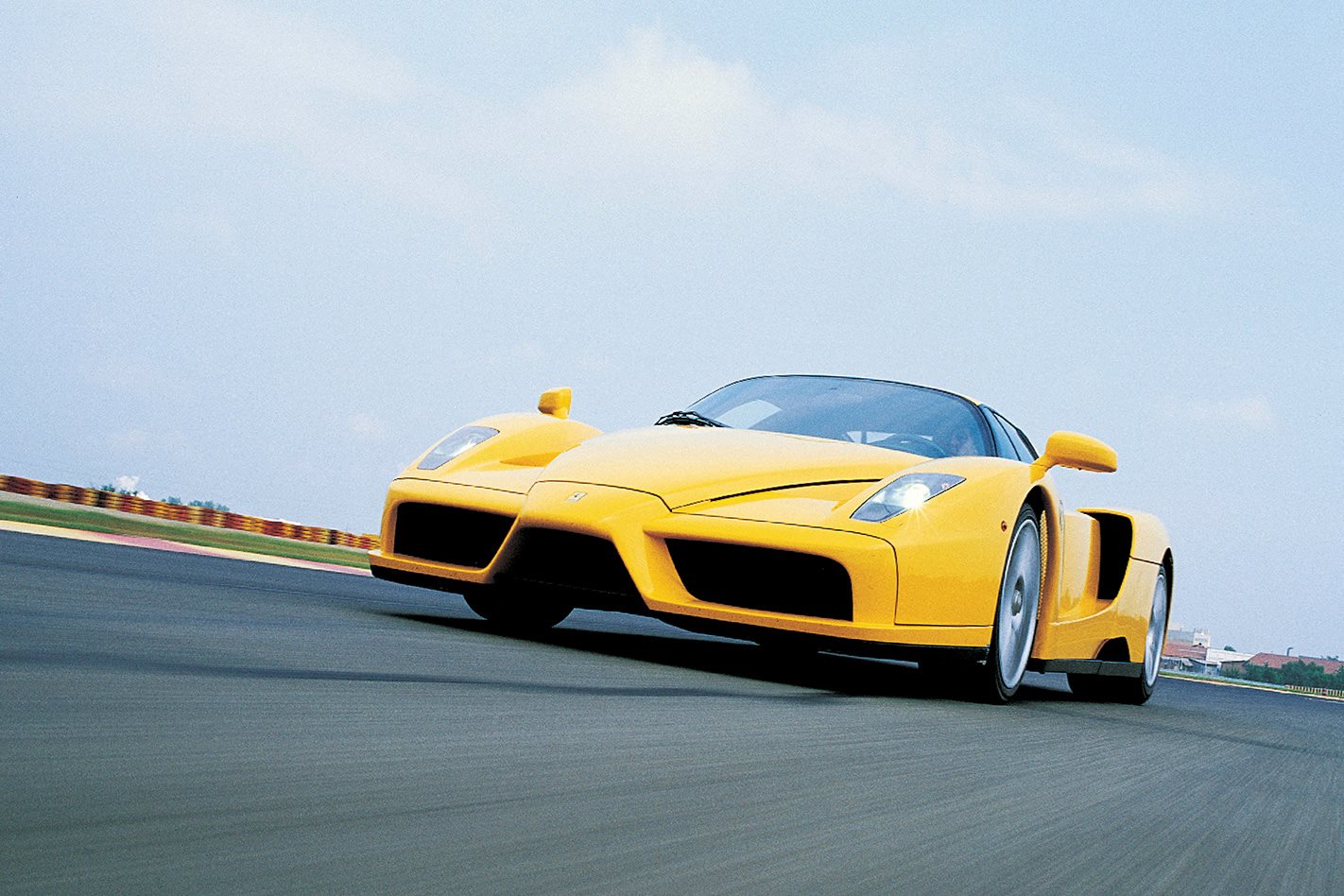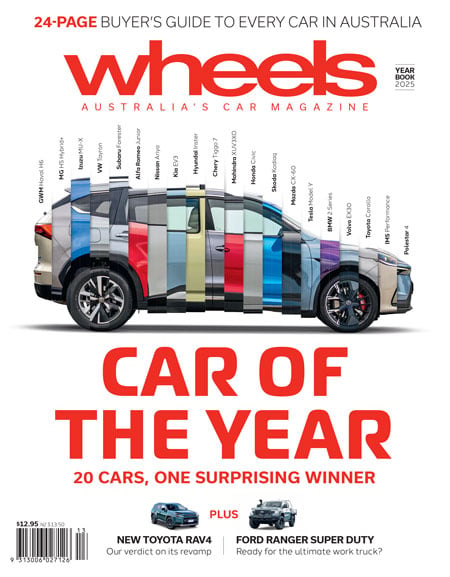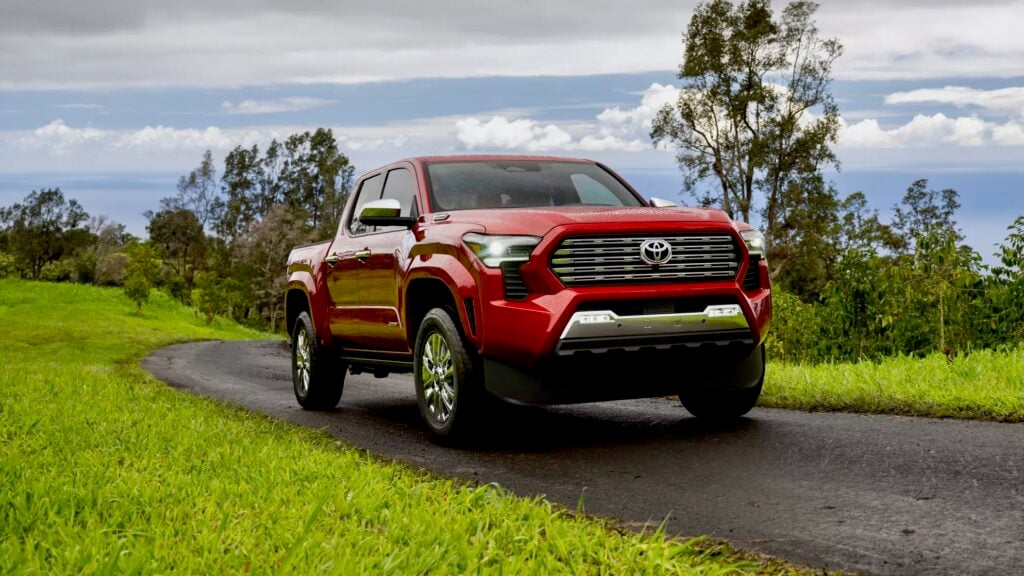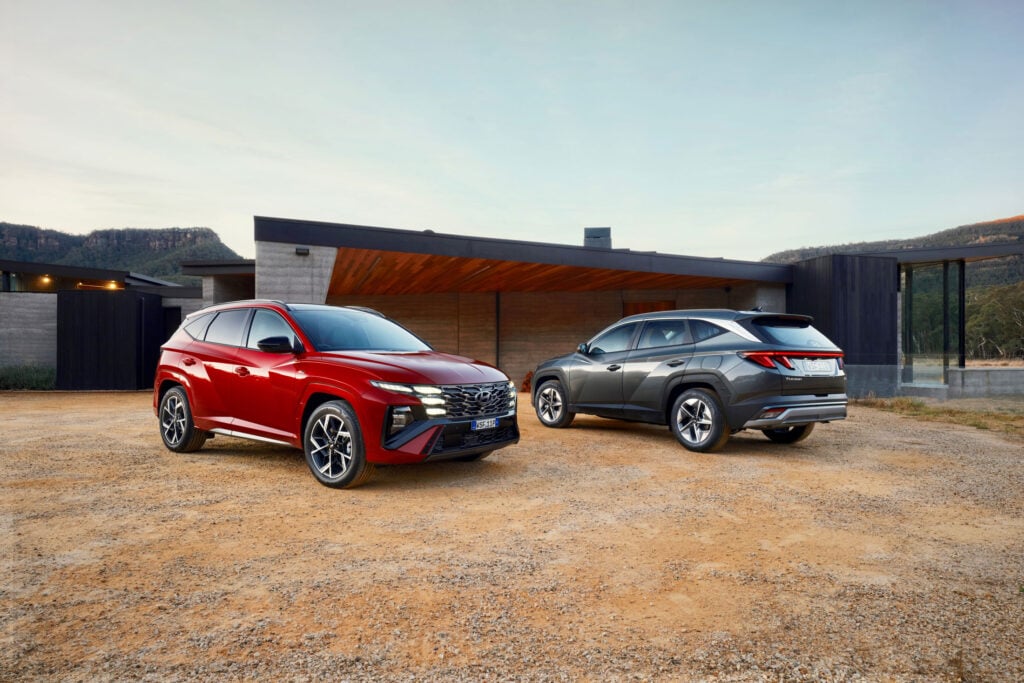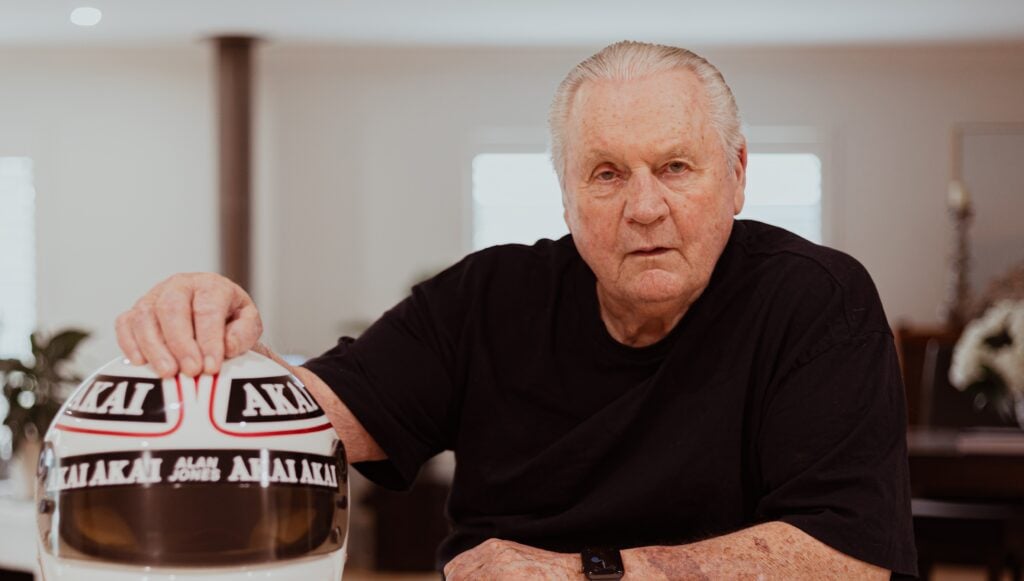YELLOW? For Maranello’s most outrageous motoring toy – the new super-supercar I’m at Fiorano to drive – to be yellow, seems almost bogus, a sin. Everybody knows Ferraris are red, and that’s the way the vast majority of the 349 limited-production-run Enzos have been ordered. Obviously Enzos also come in yellow. And black, if Ferrari president Luca di Montezemolo approves the single black car I spotted in the eight-station assembly process.
First published in the September 2002 edition of Wheels, Australia’s best car mag since 1953.
Dario Benuzzi, Ferrari’s famous rubber-burning test driver, couldn’t care less about colours. Benuzzi is keen to demonstrate the brakes. It’s the first thing he talks about. Not the performance or the aerodynamics – other areas where the Enzo leaps into the future – but only the car’s carbon-fibre Brembos. They are, he says enthusiastically, the best road-car brakes he’s experienced – up there with Ferrari’s F1 cars in terms of fade resistance and, if you accept the Enzo’s extra weight, sheer stopping power.
Yes, he would say that, wouldn’t he. However, having witnessed Benuzzi’s intimate involvement in Ferrari/Brembo’s brake-test program, stopping time and again from 320km/h to zero in a hard-worked mule on the runway of an Italian NATO airbase, I accept his judgement. I know what to expect from the brakes, but I also want to hear for myself if Ferrari has solved the noise problems, one serious flaw (others, like cold stopping, are long since solved) that has, until now, prevented carbon-fibre brakes appearing on production cars.
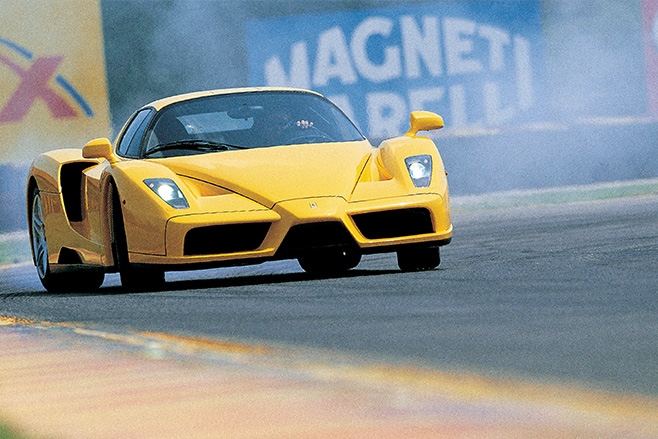
Gazing at the car, it’s clear that in Pininfarina’s sculptural shape, aerodynamics and getting air into and out of its vitals take precedence over aesthetics. Nothing, though, stops the Enzo making a huge statement. Even when it’s static. In virtually every area, this spiritual successor to the 288 GTO, F40, and F50 steps outside Ferrari’s existing order. The Enzo pushes road-car-technology barriers and incorporates enough Formula One philosophy to go way beyond being a celebration of Ferrari’s three consecutive world championship constructors’ titles (probably four by the time you read this). Luca di Montezemolo, Ferrari president, says, “I wanted to go a little bit too far in every element to build a super-extreme car. I wanted to go too far; it’s easy to come back.”
The doors, hinged at the roof and waistline, open up and forward and include a section of roof. You step in feet first and slide down into the racing bucket. Easy; natural. I later learn that lifting yourself out isn’t nearly as simple or elegant. No wasted space here – the narrow cockpit is well inboard of the outer body – but the thin Sparco racing bucket is surprisingly comfortable and a reassuringly tight fit, even before the four-point seatbelt is clicked home.
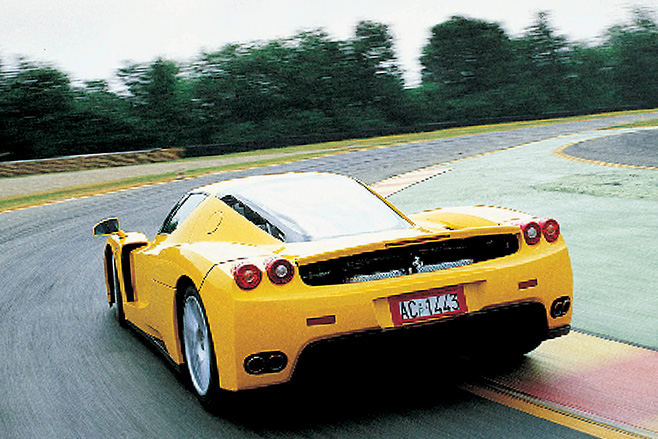
Under the staggering deceleration, my eyes water, body straining against the four-point belts. It’s as if some secondary magnetic force is slowing the Ferrari, dragging it into the track surface, reducing speed to a walking pace well before the apex. Hard on the power now, Benuzzi powers through the right-hander, effortlessly holding the Enzo in gentle oversteer, while simultaneously changing up as the Ferrari blasts forward, never losing its poise, even as it snaps to a higher gear.
Whenever he’s off the brakes, Dario buries his right foot to the floor. Only through Fiorano’s two sweepers ishe required to back off and balance the car on the throttle. Ferrari’s other road cars are flat here. The Enzo, all 485kW meeting the blacktop, ASR intervention eliminated, demands commitment and skill as the rear wheels attempt to break loose. The Enzo, he claims as we slow down, is a monstrous 4.5-5.0 seconds a lap quicker at Fiorano than the F50. The shattered lap times are a combination of three factors: those awesome brakes, vastly superior power-to-weight ratio (355kW/tonne versus F50’s 211kW/tonne), and the level of downforce. Three-lap demonstration over, motion sickness induced in his passenger, Benuzzi proudly tells me the discs are 40,000 test kilometres old, and have been through a series of 320km/h-to-zero tests.
Clearly these are no ordinary brakes. Until May, Ferrari wasn’t sure if Brembo could solve the cold-performance problems of its new 380mm Carbon-Ceramic Material (CCM) system, and insisted on a parallel development program for conventional discs. Now, convinced of the CCM brakes, Ferrari boasts a significant 12.5kg weight saving and consistent stopping, regardless.
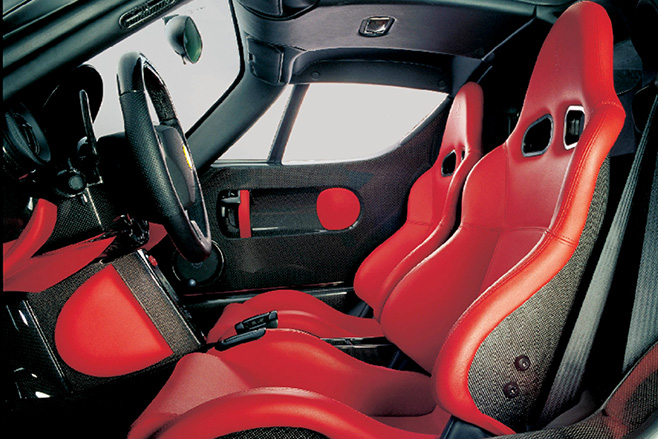
In imitation of Schumacher’s Sunday car, many of the controls have moved to the steering wheel, while a row of warning lights built into the upper section flash in 500rpm segments beyond 5500rpm. Hit the red start button, foot on the alloy brake, and the starter motor comes alive, spinning the V12 into a whoop before it settles to a busy idle.
You shift gears F1-style by steering-column-mounted paddles, but, unlike the 360/575M, there’s no auto mode. Squeeze the accelerator and the Enzo slides smoothly away, no awkward clutch take-up, no hesitation. I’m in learning mode, short shifting to second and third, conscious of the engine’s remarkable flexibility, aware that, in contrast to the F50, this is one supercar you can bumble along. The power steering is quick (just 2.2 turns) and fluid, the car responding instantly, so that it always feels wieldy, yet without any nervousness at 200km/h. Immediately, the Ferrari Enzo feels easy to drive and far from intimidating, even as I begin to tap into the lower boundaries of its mighty power band. Within a lap, I’m hitting 240km/h on the straight and using all the brakes’ power. They rumble at every stop, so there’s no getting away from the fact that the brakes are noisy. Still, the pedal action is progressive and firm, without being excessively heavy, even in a brutal stop.
The Enzo delivers sound on demand. On a light throttle, the engine is a distant rumble. Push, and the computer knows by throttle position/revs/speed sensors when to open the exhaust by-pass valves, kicking off a deep, smooth, goose-bump-inducing howl. You take the circa-3.5secs to 100km/h for granted, the Enzo passing from leisurely to 250km/h seemingly without going through any intermediate stage. At any revs, at any speed, the Enzo’s tacho needle spins quickly, climbing rapidly through an arc, as the engine fires the car forward. The performance is amazingly accessible; the Enzo is far more effective at low revs than the F50.
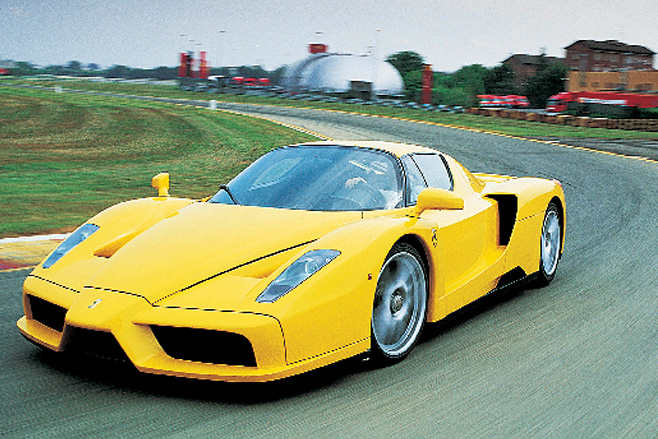
To keep control in the real world, world champ Michael Schumacher insisted Ferrari lower the threshold of the ASR intervention in its default mode. You understand why when the Enzo is capable of lighting up the rear tyres on a dry road in any of the first three gears, if the ASR is off. You don’t have to ask about wet-road adhesion. You raise the level at which it intrudes in Race mode – to permit throttle adjustability – but Ferrari recommends you only turn off ASR for track work. In tight corners the Enzo understeers moderately, the engine shutting down quickly if you get ambitious in the default setting. Boost speeds to above 130km/h and increasingly you feel the downforce working, the handling balance changing to whatever the driver’s right foot demands, provided you operate in Race-mode. Driving, then, is about control and power, and achieving a balance between the two. The pushrod double-wishbone front and rear suspension works with continuously variable dampers to maximise body control and comfort as required, and though Fiorano is no place to judge ride comfort and refinement, the Enzo never feels harsh or excessively taut.
It should be clear the Enzo requires a massive upward adjustment of expectations. No surprise that even at its elevated price, all 349 Enzos are sold. You could argue that the Enzo is an automotive toy for wealthy collectors, rather than a dynamic wonder. But that ignores the new Ferrari’s accessibility and real virtues that advance it beyond McLaren’s F1. If the F40 was brutally fast and yet practical, and the F50 a minimalist Barchetta, its performance and usability compromised by its direct F1 links, the Enzo combines their virtues and truly elevates the supercar to a new level. Even in yellow.
Enzo fast facts
There’s more to a new Ferrari than red paint
1. Before formal Enzo development began, Ferrari organised casual lunches at Cavallino between the F1 and road car engineers to exchange ideas — Ross Brawn (F1 technical director) and Rory Byrne (F1 chief designer) included.
2. Because the project started without a name, somebody decided the usual F should be joined with X … because, in mathematics, X is something you don’t know.
3. Giuseppe Petrotta, FX project leader, is ex-Osella, ex-Alfa F1, and spent 1990/91 working with Ferrari’s F1 team before moving to road-car-suspension development.
4. At 350km/h, with sixth gear giving 44km/h per 1000rpm, the Enzo is pulling just under 8000rpm, 200rpm beyond maximum power.
5. Safety, emissions, and homologation requirements contributed at least 150kg to the Enzo’s 1365kg overall weight — 65kg over the original target.
6. Two parallel brake programs for the Enzo compared conventional steel brakes and Brembo’s new Carbon-Ceramic Material (CCM) system, before a May decision in favour of CCM.
7. Ferrari’s claimed 19.6secs time for the standing kilometre exactly matches the time independently recorded by the McLaren F1.
8. Two alloy fuel tanks, totalling 110 litres and served by one filler, are housed in a well between cabin and engine firewall.
9. The Sparco leather-trimmed carbonfibre racing bucket weighs 12.4kg. Ferrari claims it’s the lightest homologated seat in a production car.
10. Stefano Carmassi, Ferrari’s aero guru says, “It’s easy to build a car capable of 300km/h. We wanted a car whose character allows a useable 300km/h.”

